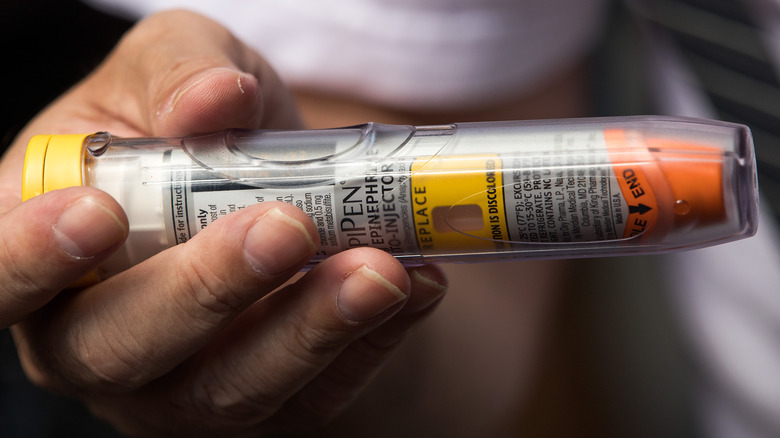When An Allergic Reaction Really Becomes Serious
An allergic reaction starts when you touch, breathe in, or swallow an allergen, per MedicineNet. And allergies run the gamut from mild reactions, like a runny nose to a severe reaction such as difficulty breathing, swollen or itchy throat, vomiting, diarrhea, or fainting. This type of reaction is called anaphylaxis. And because it typically happens fast and can be life-threatening, it requires immediate medical attention, according to the Asthma and Allergy Foundation of America.
Not all allergic reactions fall neatly into a mild or severe category, however. Some reactions start off as mild and then suddenly progress to severe (via WebMD). Because allergic reactions vary from individual to individual (and from one attack to the next), plus in the length of time they take to develop — from seconds after exposure to an allergen to over 24 hours later (per Everyday Health) – it can be difficult to know when it becomes an emergency that requires urgent treatment.
Symptoms of trouble
The body's response to an allergen is to produce a type of protein called IgE, which binds with the molecules of the allergen (via MedicineNet). This attachment leads to the release of histamines, chemicals that cause symptoms of an allergic reaction, such as itchy eyes. Most times these symptoms are self-limiting or easily treated.
However, according to a 2017 report in the Journal of Allergy and Clinical Immunology, 1.6% and 5.1% of Americans have experienced allergic reactions that progressed to anaphylaxis. Symptoms of anaphylaxis include wheezing, shortness of breath, itchy lips or mouth, trouble swallowing, vomiting, diarrhea or cramps, and dizziness, among other symptoms. Some people have reported experiencing a "sense of doom" during anaphylaxis as well, WebMD explained.
One sign that an allergic reaction is heading toward, or has become, anaphylaxis is when symptoms involve more than one part or system of the body — for instance, hives and an itchy mouth (per Everyday Health). Even if an allergic reaction produces manageable symptoms, such as a runny nose or limited rash, you may not be in the clear. Within a half-hour, more serious signs may appear. Finally, keep in mind it's also possible, after recovering from anaphylaxis, to have a second, stronger, anaphylactic attack in the next 12 hours. About 20% of people experience this, called biphasic anaphylaxis.
Treatment for anaphylaxis
If you have allergies or asthma, have had anaphylaxis before (even if it was mild), or have a family history of anaphylaxis, you're at higher risk of experiencing it (via WebMD) during an allergy attack. A few other conditions including heart disease may also be a risk factor (per Mayo Clinic).
If anaphylactic symptoms develop, don't try to wait it out and see if they go away. "The people who die from anaphylaxis are those who had a delay in treatment," Scott H. Sicherer, chief of the division of allergy and immunology in the department of pediatrics at Mount Sinai Hospital in New York City, told Everyday Health.
The only effective treatment for anaphylaxis is injectable epinephrine. If you've had anaphylaxis before, you likely have an epinephrine auto-injector, or EpiPen, on hand (or you should since subsequent anaphylactic reactions are generally more severe than the first). Epinephrine is not dangerous, and in the case of a severe reaction, it needs to be administered as soon as possible.
If epinephrine is not available, call 911 immediately. Every second can mean the difference between life and death, particularly for a child. Even if you have an EpiPen on hand, you still need to go to the emergency room. You should be there for at least four hours to be sure you don't experience biphasic anaphylaxis.
Causes of severe allergic reactions
It is important to identify the cause of anaphylaxis so you can avoid it in the future. The most common cause in adults is medicine: penicillin, aspirin, and ibuprofen, among others. In children, food is most likely the cause of an allergy, such as peanuts, fish, milk, eggs, soy, and wheat. Other allergic triggers include pollen, bug stings or bites, and latex. In rare cases, exercise can bring on anaphylaxis (per WebMD).
Just because you've eaten a food or taken a medication before, it doesn't mean you won't react to it. Sometimes it takes multiple encounters with a substance to develop an allergy. To complicate matters when trying to uncover what caused an anaphylactic reaction, symptoms might only occur when there's a combination of triggers, such as breathing in ragweed pollen and eating melons or bananas. A food diary might be helpful in identifying the culprit (or culprits).




